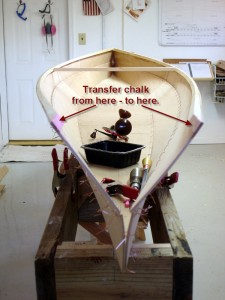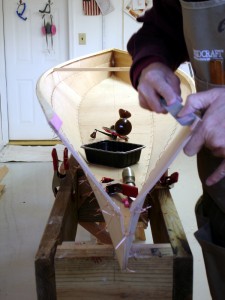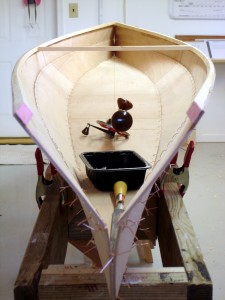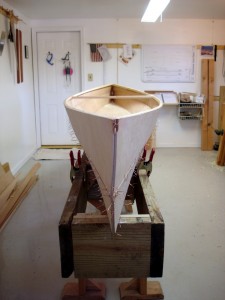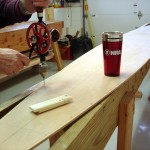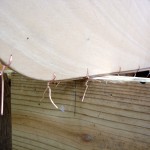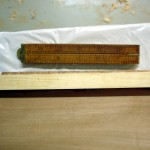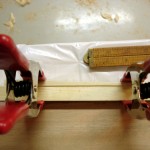Just as there are few straight lines in a boat, there are few 90 degree joins. Consider the join of the top planks at either end of the boat, an acute angle. These kinds of joins, sometimes with compound angles, are hard to cut exactly with the first cut. I sneak up on the join by cutting a generous approximation and then trimming to exactness with a rasp. This works OK for small structural members such as the sheer clamp which is only 1/2 inch by 3/4 inch.
I made the cut mark on the top of the sheer clamp by holding the plank in what I hope will be its final position and then sighting along a center line that is drawn on the boat’s bottom board. The plank was so near vertical that the cut needed no compound adjustment. Sorry for no pictures of that cut, it was chaotic enough cutting a free floating floppy thing in mid air without also having to manage a camera. Then, as it says on the shampoo bottle, “rinse and repeat” for the matching cuts.
Now, the fun part, trimming to fit. A good rasp makes quick work of this, but only if you know where to use it. I learned this chalk trick technique from Greg Rössell at the Wooden Boat School. It’s very simple and works incredibly well. In words: Mark one part of the join with bright chalk. Rub that part against the other part of the join where it will leave a trace on the high point(s) of contact. Remove the high point. “Rinse and repeat” until the rubbing produces an even transfer. Done! Click on any of the images for a larger version.
Stitch-n-Glue vs. Traditional
Responding to Al Navas’ comment wondering how the epoxy is used in stitch-n-glue construction, here’a very short and woefully incomplete comparison of two boat building techniques.
Traditional boat building, such as my previous boat Eva-Won, uses solid wood components, frames, bulkheads, and planks that are generally nailed to each other. The joins between planks are made watertight with caulking, usually a flexible compound. All of the wood parts expand and contract independently with changes in moisture, staying more or less watertight. Some joins, such as the sheer clamp, use epoxy as a simple glue.
Stitch-n-Glue construction uses marine grade plywood, much thinner and lighter than traditional boat lumber. As seen in the previous post, the parts are stitched together. Then, thickened epoxy combines with strips of fiberglass cloth to glue and strengthen the joins. The exterior is then covered with fiberglass cloth that is adhered (and filled) with epoxy. Surfaces that are not fiberglassed are clear coated with epoxy. The result has almost no structural components, depending on monocoque construction for strength. Since all the wood is encased, there is less moisture related movement than with traditional construction.
Pros and cons of each technique have been omitted for your reading pleasure.
